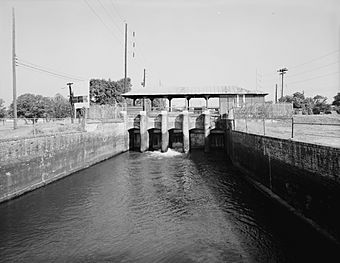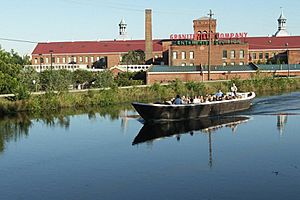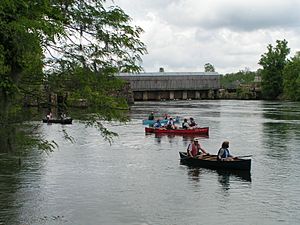Augusta Canal facts for kids
|
Historic Augusta Canal and Industrial District
|
|

Augusta Canal
|
|
| Location | Augusta, Georgia / Columbia County, Georgia |
|---|---|
| Area | 225 acres (91 ha) |
| Built | 1845 |
| Architect | Multiple |
| Architectural style | Romanesque |
| NRHP reference No. | 71000285 |
Quick facts for kids Significant dates |
|
| Added to NRHP | May 27, 1971 |
| Designated NHLD | December 22, 1977 |
The Augusta Canal is a really old and important canal in Augusta, Georgia, United States. It gets its water from the Savannah River and flows for about 13 miles (21 km) through Augusta. The water then goes back into the river. People built it to use the river's power to run factories, move goods, and supply clean drinking water to the city. It's special because it's the only canal in the U.S. that's still used today for all those original reasons: power, transportation, and drinking water!
Contents
The Canal's Story: A Look Back in Time
How the Augusta Canal Was Built
The Augusta Canal was finished in 1845. It was built to provide water, power, and a way to transport goods for the city of Augusta. This canal was one of the few successful industrial canals in the Southern United States.
During its construction, a group called the Canal Commission led the project. Henry Harford Cumming was in charge of this group. He even paid a railroad engineer named John Edgar Thomson to survey the land for the canal.
In 1847, the first factory, a saw and gristmill (which grinds grain), started being built. This was at the spot where the Enterprise Mill is today. Soon after, the Augusta Manufacturing Company built a huge four-story textile factory. These were just the first of many factories that would be built along the Augusta Canal.
The Canal During the Civil War
By the time of the American Civil War, Augusta was one of the few places in the South that made many things. The power and water transportation from the canal helped make Augusta an important center for making supplies for the war.
Because of the canal, Confederate Colonel George Washington Rains chose Augusta for the Confederate Powderworks. These 28 buildings made gunpowder and stretched for 2 miles (3.2 km) along the canal. They were the only buildings designed, built, and paid for by the Confederate government. Other war factories also opened near the canal.
As the Civil War reached Georgia in 1864, people worried that U.S. General William Tecumseh Sherman would attack Augusta. But Sherman's march through the South did not touch Augusta. This meant the city ended the war in much better shape than many other Southern cities. Its population had doubled, and it had money to help it recover and even expand the canal.
Growing Bigger: The Canal in the Late 1800s
The canal was made even larger in 1875. This led to a time of great growth for Augusta. New factories like the Enterprise Mill, King Mill, and Sibley Mill were built. The Lombard Ironworks and many other businesses also opened or grew.
Many people who lived on farms moved to the city to work in these mills. This included women and children. These factories led to the creation of "mill villages" where the workers lived close by.
In the 1890s, Augusta replaced its old water pumping station with a new, impressive building along the canal. This building is still used by the city today. As electricity became more common, Augusta started using the canal's flowing water to create electricity. By 1892, Augusta had both electric streetcars and street lights. It was the first Southern city to have these modern features!
Challenges and Comebacks: The Canal in the 1900s
Flooding was a big problem in Augusta during the early 1900s. After major floods in the 1920s and 1930s, many workers were hired to fix and improve the canal. They built a new spillway (a channel for excess water) and straightened parts of the canal.
By the middle of the 20th century, the canal was not well cared for. Textile factories began to close, and the city's industrial activity moved to other areas. At one point in the 1960s, some city leaders even thought about draining the canal to build a superhighway.
But people started to become interested in saving the Augusta Canal in the 1970s. A state park was suggested, but it never happened. In 1989, the state legislature created the Augusta Canal Authority. This group now manages the canal. In 1993, the Authority made a big plan for how the canal could be developed. Then, in 1996, the U.S. Congress named the Augusta Canal a National Heritage Area. It was the first place in Georgia to get this special title!
The Canal Today: A New Chapter in the 2000s
The Augusta Canal Authority continued to work on its plan. In 2003, the Augusta Canal Interpretive Center opened in the renovated Enterprise Mill. This center is now called the Discovery Center. In late 2003 and early 2004, two modern "Petersburg boats" started offering guided tours. These boats are like the old cargo vessels that once carried cotton and farm goods along the canal.
Today, the Augusta Canal Authority owns the King and Sibley textile mills.
Special Recognitions for the Augusta Canal
The Augusta Canal, along with four historic industrial areas, is part of the Historic Augusta Canal and Industrial District. This district was named a National Historic Landmark in 1977.
The Augusta Canal National Heritage Area was given its name by Congress in 1996. It was the first National Heritage Area in Georgia. In 2018, the American Society of Civil Engineers also named the Augusta Canal & Industrial District a National Historic Civil Engineering Landmark.
What You Can Do at the Augusta Canal Today
The Augusta Canal is still a main source of drinking water for Augusta. It has also become a central part of the city's redevelopment. Old textile mills, like the Enterprise and Sutherland mills, have been turned into fancy offices and loft apartments. New buildings, such as the Kroc Center and Canalside Apartments, have also been built. Other projects, like the Harrisburg Canal Village, are being planned or are under construction.
The canal is now very popular for fun activities. You can take daily guided tours on electric boats, go paddling or kayaking, and explore its multi-use trail. The 7-mile-long (11 km) towpath (a path originally used to pull boats) along the canal's first level is a main part of the trail system. There are also newer trails like the River Levee Trail, Third Level Trail, and a single-track mountain bike trail for mountain biking.
Augusta Canal Discovery Center at Enterprise Mill
The Enterprise Mill in Augusta is home to the Augusta Canal Discovery Center at Enterprise Mill. This center was known as the Interpretive Center from 2003 to 2013. It's an interactive museum that shows you how the canal was built and how it works. You can learn about hydroelectricity, the history of the mills along the canal, and what life was like for mill workers. It also covers how the mills declined in the 20th century and what that meant for the canal. Boat tours of the Canal also start from the Discovery Center.
See also
- Butt Memorial Bridge — a bridge that crosses the Augusta Canal
- History of Augusta, Georgia
- List of National Historic Landmarks in Georgia (U.S. state)








